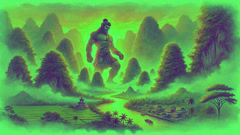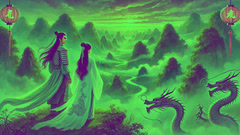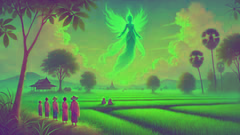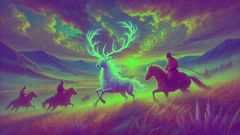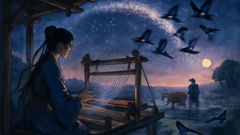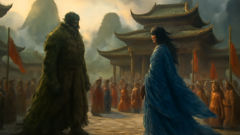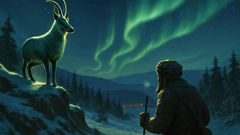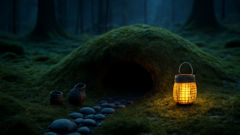Introduction
On the low plains where the Mekong slows and fans into channels, and where the Red River cuts its ancient braid through paddy and reed, people still speak the dragon's name with an easy reverence. The Indochinese water dragon is less a single beast than a presence braided into seasons, a voice in the river's murmur. Villages were built with an eye on its temperament. Offerings were made at riverbanks before planting. Fishermen trimmed their nets to its moods. When the dragon stirred, fish gathered; when it sighed, rain came. When it withdrew, drought followed and men knelt in mud and prayed. This is a tale of water and wood, of temples built on stilts and wooden boats that cut green reflections, of a dragon whose scales shone like wet moonlight and whose eyes held the wet wisdom of moving currents. It is a story of how a single rồng became interwoven with the livelihoods of ricefields and the prayers of mothers who watched children grow. It speaks of respect rather than dominion, of bargains struck with incense and rice cakes, of courage tested when river and human wills clashed. The tale follows a young woman named Liem, a village elder, and a dragon who taught them both that prosperity is not a gift to be taken lightly. In the hush before monsoon, as frogs lined the paddies and roosters kept watch at dawn, the story begins where river and sky meet, where names are offered to tides and futures are carved by the water's hand.
The River Remembers
The first time Liem saw the dragon she was twelve and small enough to curl inside her grandmother's lap while the story was told. It was not a proper sighting in the public sense; children were taught to listen for signs rather than to confirm grandeur. That season the river's voice changed. Currents which had been mild tugged with new impatience. Her grandmother, Minh, ran her gnarled fingers over a wooden carving of a rồng, smoothing worn edges as if to reassure the wood it would not be forgotten. Minh had eyes that had seen the river in times of plenty and famine; she could remember when the villagers had to borrow seed rice, when the boats came back light, when temples were rebuilt after floods and when offerings were enough to make the dragon linger. Minh told Liem that the dragon did not force kindness; it reflected it. If the village treated the river as kin, it would return blessings. If they took without giving, the river would teach them caution in the currency it knew best: water.

The tales told by riverbanks were full of small moral arithmetic. A fisher who refused to share the first catch with neighbors would find his nets tangled and his fish slipping through tears in the net. A farmer who decorated his fields with wind chimes and left a bowl of rice at the channel would wake to find the first rains came early and fat with promise. These were not invisible laws, Minh insisted, but conversations. The river answered in currents and in rains, in the migration of fish and in the bloom of lotus. If the dragon was a teacher, it taught lessons in patience, reciprocity, and humility.
When Liem grew older she learned to read the river's subtle grammar. The color and smell of the water spoke of upriver fires or distant rains. The birds that rested on bamboo poles—herons, kingfishers—were like punctuation. One autumn, as drums of rain failed to drum, the water stilled and the reeds sagged. Fish were scarce. People offered what they could: rice cakes wrapped in banana leaves, little boats of paper set afloat with candles. They walked to the bank at dusk carrying baskets of flowers and small votives. Yet the dragon did not answer with storms as it had before. The elders whispered about a ledger in the current, a tally of debts recorded in the riverbed: years when wood was taken thoughtlessly for palaces, when nets had been cast too deep and too often. Minh said the dragon remembered, not with malice, but with the measured impartiality of water finding its level.
Then there came a moment when the river itself seemed to change tone. In the cooling light of an early evening, Liem saw a disturbance where the water should have been plain. Foam rose in a slow spiral, and the river's surface shimmered as if a wind had passed beneath it. Her heart thudded against her ribs; stories had prepared her for awe, but not for the sudden presence of it. A head emerged, not monstrous but noble. Scales flashed in a pattern like lacquered mother-of-pearl. A pair of long whiskers twined like woven rice stalks. Eyes, deep and turned inward like two ponds, observed the small human figures on the bank with something that was not curiosity but recognition. When it spoke, the voice was like a submerged bell: deep, resonant, full of current. The villagers fell silent, the air heavy with expectation. Liem felt the river's memory sweep through her, a collage of storms, harvests, births, and funerals, as if the dragon held every small human act and every flood in its slow, patient accounting.
Rather than devastation, the dragon offered a question. It asked for a covenant: a promise of mindful stewardship from one generation that would be kept by the next. It asked that the villagers mend nets rather than cast more, that they plant trees along the banks, that festivals be part of the farming year. In return, it promised measured rains, an easing of the tide when boats were full, and the secret knowledge where shoals would gather. It named bounds and blessings with a voice that sounded like the river itself negotiating. Minh stepped forward and, with hands that told of many years tending soil, accepted. She pledged on behalf of the community with words that were simple as rice and as heavy as stone. The dragon dipped its head in agreement, and for reasons older than gratitude, the river answered. Clouds gathered in unlikely skies. Rains arrived not early nor late but exactly when the fields needed them.
Over seasons the villagers found that partnership changed them more than it changed the dragon. Liem watched neighbors plant trees and harvest with deliberation. Children learned that a festival could be the measure of respect as much as a day of song. The dragon's presence became soundtrack and structure—ritual around planting and harvest, a calendar written in the language of currents. Yet there were complications. Prosperity bred carelessness in the periphery. Travelers and traders, seeing green paddies and heavy nets, sometimes removed things with less thought. One year a new mill upstream lumbered too close to the river's banks, cutting trees and churning silt into the water. Fish migrations skewed. The dragon's patience thinned like an old rope under a new strain. It did not lash with immediate fury but withdrew, curling into a cool, deep channel and letting the water hollow out in silence. The village felt the absence like a missing tooth, an ache that made offers heavier and work quieter. Liem, now a young woman who could steer a boat by star and memory, learned that keeping a covenant required vigilance. She began to walk the banks at dawn, urging families to plant shade trees and teaching children how to build small sanctuaries for water birds. The dragon watched with those pond-like eyes and sometimes, when Liem sang an old lullaby to the river's fringe, a current would lift her boat as if in thanks. In time the mill's owners, shamed by the river's decline and convinced by the earnestness of Liem's people, staggered their operation and replanted a strip of mangrove along the shore. The water cleared, fish returned in slow trios, and the dragon surfaced again to run the river's finger over the village like a blessing. But the lesson that Liem carried forward was unvarnished: partnership with a river is labor as much as worship, and living by water is a continuous, changing craft.
Of Rain and Reckoning
As Liem's life braided with the river's moods, the wider world changed too. Traders came by boat with porcelain and silk, and with them came news of distant cities and the shifting fortunes of kings. Stories arrived like gusts that lasted a day—talk of new taxes, of floods that drowned whole townships upriver, of droughts elsewhere. The dragon, ever attuned to weather and human pattern, shifted its station with these changes. It was not purely reactionary; the creature responded to cause and consequence, to a tapestry of acts stretching beyond the valley. When a war displaced peoples and forced refugees to camp along the river, the dragon observed. It softened the current near these makeshift encampments so children could learn to fish, and it curled in the deeper channel as if offering shelter. But when greed took hold—boats stripped of timber, reeds burned by those who thought land improved by fire—the dragon answered in a manner both measured and stark. Water that had once visited ricefields retreated. Ponds dried into cracked skin. Families found that their wells had receded and goats languished. This was never a story of arbitrary anger but of balance. The dragon did what rivers do: it sought equilibrium.

Liem found herself at the heart of a difficult season. That year, a drought came with a stubborn beauty. The skies wore a relentless, unblinking blue. Farmers watched seedlings curl brown. Elders muttered to one another about debts and the ledger the water kept. The village council gathered beneath the fig tree and debated what to do. Some wanted to send traders to buy rice from far-off towns. Others argued for rationing. Liem suggested a daring third path, one that would echo the dragon's covenant: a shared migration. Boats from several villages would travel together upriver to talk with settlements whose waters still ran fuller, to mend old quarrels, and to offer help in exchange for shared seed and knowledge of conservation. It was a gamble. It required trust among people who had in the last years been drawn apart by need.
Before they left, Liem made offerings at the stone shrine by the bank. She filled a woven tray with jasmine, rice, and the lacquered shell of a snail, placing it carefully where water and earth met. Speaking softly, she promised to ask favors not for herself but for the many. The dragon, listening in its slow, aquatic wisdom, answered in a way that surprised everyone: a single, sustained rain fell on the night before the boats set off. It was not enough to end drought, but enough to fill jugs and soften soil, and in the morning villagers left with hope braided into oar grips. The upriver journey was a mosaic of kindnesses. Villages met them with shelters and stewed fish, and Liem's small group learned ancient techniques to store water in clay vessels and to plant cyclical trees whose roots held banks in place. They traded knowledge more than seed: how to stagger planting by pocket weather, how to listen to birds for signs of rain, how to let some fields lie fallow as an act of future mercy.
When they returned, laden with knowledge and a modest cache of seed, the dragon met them with a current that moaned like an old bell. It had been watching. Liem knelt and handed over a small bundle wrapped in cloth—tokens of diplomacy and a promise that neighboring villages would be treated as kin, not competition. The dragon's head lowered, and the river's voice rose in a long, slow sound that felt like permission. Rain followed in a pattern that made sense: gentle at first, then pooling and generous without washing seed from the soil. Crops grew sturdier because of the measured rains and because communities now planned not only for harvest but for stewardship. The dragon had always taught through consequence, but now Liem saw the other side of the equation. When people learned to shape their own behavior, the dragon's generosity multiplied, not as magic but as a predictable response to care.
Yet not all lessons were soft. There were times when officials far from the river sought to harness its power and turned the current into conquest. Engineers proposed levees and channels that would favor one province at the cost of another. Politics, ever restless, sought to quantify the dragon the way men counted rice. The dragon, unquantifiable by charts and equations, responded with the language it knew: water. It shifted flows in subtle ways, undoing forced channels, depositing silt where it was least wanted and where it would hurt the most. Men with ink-stained ledgers called it caprice; those whose rice withered called it justice. Liem, now older and called by some the river's steward, walked delicate paths. She brokered talks between engineers and elders. She reminded magistrates that a river's work is not only to service mills and cities but to sustain the web of life along its banks. Her voice could not command edicts, but it could stitch conversation and history into policy. Slowly, in fits and starts, some plans were amended to include fish passages and to preserve the trees that steadied river banks. Sometimes the dragon's hand was swift and terrible, but more often it was patient and corrective, coaxing humans to remember their part in a larger design.
In the long arc of seasons, the dragon taught that prosperity and reckoning are twin faces. Rain comes as a promise fulfilled when obligations are met, and drought follows as a teacher when duties are neglected. Liem learned that pride could blind a village to slow erosions and that humility could keep a community alive through lean years. The dragon's presence encouraged celebration and restraint in equal measure. Festivals after harvest were no longer mere feasts; they were public accounting where gratitude made the ledger balanced. Stories of the dragon spread to neighboring regions, and with them came adaptations: offerings unique to each valley, songs that reflected local birds, dances that told of fish and flood. The legend aged like lacquer, gaining layers, and each generation added its own cautionary edges. But through all adaptations the dragon's core remained: a being whose interests were the flow of water and the health of those who lived beside it. Liem, at season's turn, understood that the dragon did not belong to any one village. It belonged to all the river's children. Her stewardship ended not with dominance but with a handing on, a carefully stored ritual, a song for the next child leaning into an elder's lap, set to be sung beside the same water that would one day answer or withhold according to how well humans had kept their side of the conversation.
Conclusion
The tale of the Indochinese water dragon is not a single event but a map of living practice. Across centuries the rồng has been gulled by greed and soothed by song, has withdrawn as punishment and surfaced as teacher. Liem's life, braided with river and ritual, shows that stewardship is an active, communal craft and that reverence without action withers. This legend, rooted in Vietnamese riverlands, is an invitation to think of nature as interlocutor—an old, patient mind that rewards reciprocity. It asks readers today to consider local waters, to plant trees beside banks, to protect wetlands and to keep small promises made at shrines and kitchens. Rivers remember more than names; they remember patterns. If modern hands seek to harness a waterway only for profit, the ledger will be exacting. If they listen and share, rivers will answer in abundance. The rồng of the Mekong and the Red River remains in stories, in temple carvings, in lullabies and harvest songs. It resides in the practice of leaving the first cake for the current, in the planting of a tree that will shade a child’s canoe, in the mutual aid that binds villages together. In the end what the legend preserves is the sense that prosperity is relational: it arises when humans live with attentive humility and regard the river as kin rather than resource. This is the lasting counsel the dragon offers, carried in ripples that become tides and in small, steady acts that grow forests on river banks over generations.


